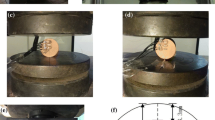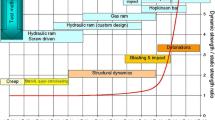Abstract
The real distribution of pressure on the disc in the Brazilian test in this paper is considered to be nonuniform. The simplest full-field analytical solutions for the stress and the displacement fields in a Brazilian disc under nonuniform pressure are given by the integral method. The formulae for tensile strength and elastic modulus determined by the Brazilian test under nonuniform pressures are presented based on the Griffith criterion and the analytical solutions in this paper. The Brazilian splitting test is carried out with uncracked sandstone discs under plat platens and curved jaws, and the contact angle is measured by the indentation method. The results show that the effects of the load distributions are great on the stress and the displacement fields near the loaded area of the disc. Using the formula recommended by the American Society for Testing and Materials (ASTM) and the International Society for Rock Mechanics (ISRM), the tensile strength of rock materials is underestimated or overestimated when the contact angle is small or large. With the increase in the contact angle, the initiation position of the crack moves from the edge to the centre of the disc, and the maximum load for the failure of the disc also increases. The distribution form has a certain influence on the determination of the tensile strength and the elastic modulus. The influence of the distribution form on the determination of tensile strength could be ignored when the contact angle γ ≥ 15°. The experimental results show that the results of the tensile strength calculated with the formula recommended by the ASTM and the ISRM are smaller than those in this paper. It is suggested that the calculation formula for the tensile strength in the Brazilian test be modified using the formula in this paper when γ ≥ 13.84°.

















Similar content being viewed by others
Abbreviations
- a n, b n, c n (n = i, i − 1):
-
Coefficients
- ASTM:
-
American Society for Testing and Materials
- A ji, C ji (j = 1, 2, 3; i = 1, 2,…,n) :
-
Angle coefficients
- B :
-
Thickness of disc
- C 0 :
-
Coefficient
- C 1, C 2 :
-
Integral constants
- E :
-
Elastic modulus
- f i :
-
Coefficient
- F E :
-
Normalised elastic modulus
- F G :
-
Normalised Griffith equivalent stress
- F u, F v :
-
Normalised radial and hoop displacements
- F θ, F rθ, F r :
-
Normalised hoop, tangential, and radial stresses
- F σt :
-
Normalised tensile strength
- ISRM:
-
International Society for Rock Mechanics
- J 1 :
-
First-order Bessel function
- k :
-
Slope of the linear section in the load–displacement curve
- n :
-
Sum coefficient
- P :
-
Compression load
- P max :
-
Maximum compression load
- q 0 :
-
Coefficient
- r, θ :
-
Polar coordinates
- R :
-
Radius of disc
- u, v :
-
Radial and hoop displacements
- w :
-
Maximum displacement
- γ :
-
Contact angle
- δ 1, δ 2 :
-
Relative errors
- ΔP, Δw :
-
Variations of load and displacement
- ε r, ε θ :
-
Radial and hoop strains
- μ :
-
Poisson's ratio
- ρ :
-
Normalised coordinate
- σ :
-
Coefficient
- σ G :
-
Griffith equivalent stress
- σ t :
-
Tensile strength
- σ 0 :
-
Maximum distribution intensity of pressure
- σ 1, σ 3 :
-
First and third principal stresses
- σ θ, τ rθ, σ r :
-
Hoop, tangential, and radial stresses
References
Zhou YX, Xia K, Li XB, Li HB, Ma GW, Zhao J et al (2012) Suggested methods for determining the dynamic strength parameters and mode-I fracture toughness of rock materials. Int J Rock Mech Min Sci 49:105–112
Yin TB, Li XB, Cao WZ, Xia KW (2015) Effects of thermal treatment on tensile strength of laurentian granite using Brazilian test. Rock Mech Rock Eng 48:2213–2223
Yu JH, Shang XC, Wu PF (2019) Influence of pressure distribution and friction on determining mechanical properties in the Brazilian test: theory and experiment. Int J Solids Struct 161:11–22
Kourkoulis SK, Markides CF, Pasiou ED (2015) A combined analytic and experimental study of the displacement field in a circular ring. Meccanica 50:493–515
Aliha MRM, Ebneabbasi P, Karimi HR, Nikbakht E (2021) A novel test device for the direct measurement of tensile strength of rock using ring shape sample. Int J Rock Mech Min Sci 139:12
Aliha MRM, Heidan-Rarani M, Shokrieh MM, Ayatollahi MR (2012) Experimental determination of tensile strength and K-Ic of polymer concretes using semi-circular bend (SCB) specimens. Struct Eng Mech 43:823–833
Carneiro FLLB A new method to determine the tensile strength of concrete.In: 5th meeting of the Brazilian association for technical rules1943. pp 126–129
Akazawa T (1943) New test method for evaluating internal stress due to compression of concrete (the splitting tension test) (Part 1). J Jpn Soc Civil Eng 29:777–787
ASTM. D3967-95a Standard test method for splitting tensile strength of intact rock core specimens. West Conshohocken, PA1995
Bieniawski ZT, Hawkes I (1978) Suggested methods for determining tensile strength of rock materials. Int J R Mech Min Sci Geomech Abstr 15:99–103
Fairhurst C (1964) On the validity of the ‘Brazilian’ test for brittle materials. Int J Rock Mech Min Sci Geomech Abstr 1:535–546
Erarslan N, Williams DJ (2012) Experimental, numerical and analytical studies on tensile strength of rocks. Int J Rock Mech Min Sci 49:21–30
Wang J, Xie L, Xie H, Ren L, He B, Li C et al (2016) Effect of layer orientation on acoustic emission characteristics of anisotropic shale in Brazilian tests. J Nat Gas Sci Eng 36:1120–1129
Hertz H (1882) Ueber die Berührung fester elastischer Körper. J für die Reine und Angewandte Mathematik 92:156–171
Kourkoulis SK, Markides CF, Chatzistergos PE (2013) The standardized Brazilian disc test as a contact problem. Int J Rock Mech Min Sci 57:132–141
Hong T, Saka N (1991) Finite element analysis of an elastic-plastic two-layer half-space: mormal contact. Wear 148:47–68
Japaridze L (2015) Stress-deformed state of cylindrical specimens during indirect tensile strength testing. J Rock Mech Geotech Eng 7:509–518
Markides CF, Kourkoulis SK (2012) The stress field in a standardized Brazilian disc: the influence of the loading type acting on the actual contact length. Rock Mech Rock Eng 45:145–158
Kourkoulis SK, Markides CF, Chatzistergos PE (2012) The Brazilian disc under parabolically varying load: theoretical and experimental study of the displacement field. Int J Solids Struct 49:959–972
Guerrero-Miguel DJ, Alvarez-Fernandez MI, Garcia-Fernandez CC, Gonzalez-Nicieza C, Menendez-Fernandez C (2019) Analytical and numerical stress field solutions in the Brazilian Test subjected to radial load distributions and their stress effects at the centre of the disk. J Eng Math 116:29–48
Markides CF, Pazis DN, Kourkoulis SK (2012) The Brazilian disc under non-uniform distribution of radial pressure and friction. Int J Rock Mech Min Sci 50:47–55
Atkinson C, Smelser RE, Sanchez J (1982) Combined mode fracture via the cracked Brazilian disk test. Int J Fract 18:279–291
Dong S, Wang Y, Xia Y (2004) Stress intensity factors for central cracked circular disk subjected to compression. Eng Fract Mech 71:1135–1148
Gutierrez-Moizant R, Ramirez-Berasategui M, Santos-Cuadros S, Garcia-Fernandez CC (2020) A novel analytical solution for the Brazilian test with loading arcs. Math Probl Eng 2020:19
Ye JH, Wu FQ, Sun JZ (2009) Estimation of the tensile elastic modulus using Brazilian disc by applying diametrically opposed concentrated loads. Int J Rock Mech Min Sci 46:568–576
Aliha MRM (2014) Indirect tensile test assessments for rock materials using 3-D disc-type specimens. Arab J Geosci 7:4757–4766
Heidari-Rarani M, Aliha MRM, Shokrieh MM, Ayatollahi MR (2014) Mechanical durability of an optimized polymer concrete under various thermal cyclic loadings – An experimental study. Constr Build Mater 64:308–315
Aliha MRM, Bahmani A, Akhondi S (2016) A novel test specimen for investigating the mixed mode I+III fracture toughness of hot mix asphalt composites: experimental and theoretical study. Int J Solids Struct 90:167–177
Hua W, Dong SM, Fan Y, Pan X, Wang QY (2017) Investigation on the correlation of mode II fracture toughness of sandstone with tensile strength. Eng Fract Mech 184:249–258
Pan X, Huang JZ, Gan ZQ, Hua W, Dong SM (2021) Investigation on mixed-mode II-III fracture of the sandstone by using eccentric cracked disk. Theoret Appl Fract Mech 115:10
Yuan R, Shen B (2017) Numerical modelling of the contact condition of a Brazilian disk test and its influence on the tensile strength of rock. Int J Rock Mech Min Sci 93:54–65
Garcia-Fernandez CC, Gonzalez-Nicieza C, Alvarez-Fernandez MI, Gutierrez-Moizant RA (2018) Analytical and experimental study of failure onset during a Brazilian test. Int J Rock Mech Min Sci 103:254–265
Erarslan N, Liang ZZ, Williams DJ (2012) Experimental and numerical studies on determination of indirect tensile strength of rocks. Rock Mech Rock Eng 45:739–751
Acknowledgements
This work was supported by the National Natural Science Foundation of China (Nos. 11872042 and 12132019), Sichuan Science and Technology Program (No. 2021YJ0357), Xichang University Science and Technology Program (YBZ202109), and China Postdoctoral Science Foundation (2019M653395).
Author information
Authors and Affiliations
Corresponding author
Ethics declarations
Conflict of interest
The authors have no conflict of interest to declare that are relevant to the content of this article.
Additional information
Publisher's Note
Springer Nature remains neutral with regard to jurisdictional claims in published maps and institutional affiliations.
Rights and permissions
Springer Nature or its licensor holds exclusive rights to this article under a publishing agreement with the author(s) or other rightsholder(s); author self-archiving of the accepted manuscript version of this article is solely governed by the terms of such publishing agreement and applicable law.
About this article
Cite this article
Tang, H., He, J., Gan, Z. et al. Tensile strength and elastic modulus determined in the Brazilian test: Theory and experiment. Meccanica 57, 2533–2552 (2022). https://doi.org/10.1007/s11012-022-01574-w
Received:
Accepted:
Published:
Issue Date:
DOI: https://doi.org/10.1007/s11012-022-01574-w




